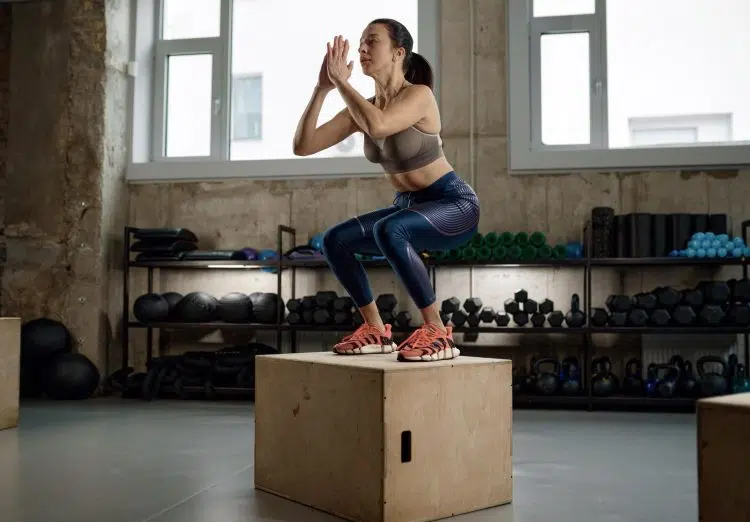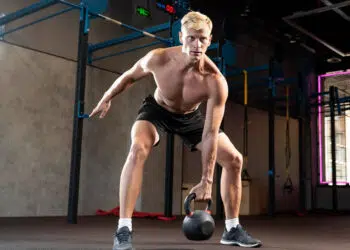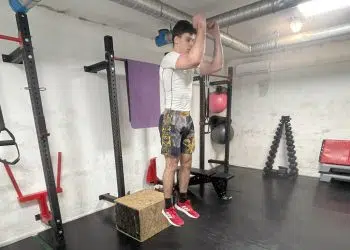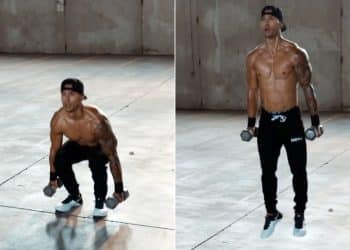Strength training is one of the most important types of exercise you can do. Whether you lift weights, use resistance bands, or do calisthenics, the list of strength training benefits is long and includes (1):
- Increased functional strength
- Elevated metabolism
- Fat loss and weight management
- Stronger bones
- More stable joints
- Lower blood glucose
- Better heart health
- Increased immune system efficiency
- Improved sports performance
- Increased muscle mass
- Improved aesthetics
As a veteran personal trainer, I’ve been helping people strength train for fitness, health, and improved sports performance for over 30 years. I’m also a former powerlifter, so I’m also a dyed-in-the-wool fan of heavy lifting.
However, I understand that conventional strength training is not ideal for everyone. It’s often reliant on access to a well-equipped gym, and workouts can be prohibitively long. So, while strength training is undeniably good for everybody’s body, some people simply cannot make it fit into their exercise schedules.
The good news is that you can achieve many of the benefits of strength training in the comfort of your own home, often in less time than many exercisers spend on their warm-ups. You’ve just got to do the right type of workout.
In this article, I discuss a training method called plyometrics and share one of my favorite short but effective full-body plyometric workouts.
What is Plyometric Training?
Level Up Your Fitness: Join our 💪 strong community in Fitness Volt Newsletter. Get daily inspiration, expert-backed workouts, nutrition tips, the latest in strength sports, and the support you need to reach your goals. Subscribe for free!
I’ve been doing plyometric training since my mid-teens. I was introduced to it by my first athletics coach when I was a long jumper and sprinter. I’ve since used plyometrics with many of my personal training clients, and the results have always been impressive.
But what is plyometrics? I’m glad you asked!
Plyometric training, also known as plyos, is a form of dynamic strength training. In simple terms, it involves quickly loading and stretching your muscles (eccentric phase) and then rapidly contracting them (concentric phase).
This load/unload sequence triggers something called the stretch-shortening cycle (SSC), which helps your muscles generate more force than they usually can.
Think of your muscles as rubber bands. The further and more rapidly you stretch a band, the more powerfully it snaps back when you release it. Plyometrics has a similar effect on your muscles, tendons, and nervous system.
Examples of plyometric exercises and activities include:
- Squat jumps
- Clapping push-ups
- Hopping
- Throwing
- Sprinting
Athletes from all sports use plyometrics to improve their performance. It’s also a valid training method for general fitness enthusiasts.
Plyometric Training Benefits
Not sure if plyometrics is the right training method for you? Consider these benefits and then decide (2):
Improved Muscle Power
Power is your ability to generate force quickly. As such, it’s an intrinsic part of most sports. Plyometric training is one of the most effective ways to increase muscle power.
Enhanced Speed and Agility
Power and speed are closely related. Plyometrics can help you run faster. The right exercises will also make you more agile, which is your ability to accelerate, decelerate, and change direction.
Better Athletic Performance
Whether you want to run faster, jump higher, throw further, or kick and punch harder, plyometrics will help. As such, plyos are a common feature in most athletic training programs.
Increased Muscle Strength
Plyometric exercises expose your muscles to a lot of resistance, both eccentrically and concentrically. This will increase your strength even though plyos don’t usually involve heavy weights.
Increased Muscle Mass
While not the best way to build muscle, plyometrics provide enough overload and muscle damage that some hypertrophy or growth is inevitable.
Injury Prevention
Plyometric training develops more robust muscles, tendons, and ligaments, reducing the risk of injuries. This is especially true for rapid decelerations, e.g., trips and falls.
Efficient Fat Burning
Plyometric exercises are very high-intensity. As such, plyo workouts require a lot of energy. This means plyometric training is a viable way to burn fat and improve body composition.
Increased Bone Density
The impact and weight-bearing nature of plyometrics puts a lot of stress on your bones, increasing osteoblast or bone-building cell activation. As a result, plyos can help increase bone mass and strength.
Time-Efficient Workouts
Plyometric training delivers excellent results in less time than a conventional strength training workout. Consequently, it’s ideal for exercisers with busy schedules.
Plyometric Safety Considerations

The benefits of plyometric training are well documented. However, as effective as this type of workout is, it’s not without drawbacks.
These include:
Level Up Your Fitness: Join our 💪 strong community in Fitness Volt Newsletter. Get daily inspiration, expert-backed workouts, nutrition tips, the latest in strength sports, and the support you need to reach your goals. Subscribe for free!
Injury risk – rapidly loading and unloading your muscles puts them under tremendous strain. As such, there is a risk of pulled muscles during plyos. Minimize this risk by warming up thoroughly before plyos and progressing gradually.
Very high impact – plyometric exercises can involve a lot of impact. This can take its toll on your muscles and joints. Avoid plyos if you have a history of ankle, knee, hip, or lower back joint problems.
Not suitable for very overweight exercisers – the heavier you are, the more impact you’ll experience during hops and jumps. This can be uncomfortable and could cause injury. Plyos are best avoided by overweight exercisers.
Not suitable for beginners – novice exercisers must master basic movements like squats, push-ups, and deadlifts before progressing to plyometric training. For example, if you can’t squat slowly with good form, the chances of doing ultra-dynamic squat jumps correctly are very low. In other words, make sure you can walk before you try to run!
May not be suitable for older exercisers – plyos increase bone density and strength. Still, they are probably too stressful for anyone already suffering from osteopenia or osteoporosis. Consequently, plyos may not be suitable for senior exercisers unless they are already involved in regular strength training.
May require an extended warm-up – while plyometric workouts tend to be quite short, their high intensity means you’ll still need to warm up thoroughly. Learn how to warm up effectively in this in-depth guide.
15-Minute Plyometric Workout
Are you ready to “jump in” to your 15-minute plyometric workout? Then let’s do it! However, before you start, don’t forget to prepare your muscles and joints with a thorough warm-up.
Start with 5-10 minutes of easy cardio followed by dynamic mobility and flexibility exercises for your main muscles and joints. Finish your warm-up with a few easy reps of each exercise.
Do the following exercises for the allotted time, moving from one movement to the next. Repeat the entire sequence three times to total 15 minutes. Note how the work periods increase and the rests decrease every two weeks. This will ensure you get fitter over the coming weeks.
| Exercise | Work/Rest | |
| 1 | 180-degree squat jumps | Week 1 & 2 – 20 seconds work/40 seconds rest
Week 3 & 4 – 25 seconds work/35 seconds rest Week 5 & 6 – 30 seconds work/30 seconds rest |
| 2 | Depth-drop push-ups | |
| 3 | Medicine ball slams | |
| 4 | Lateral bounds | |
| 5 | Medicine ball sit-up and throw |
Exercise Instructions
Get the most from your 15-minute plyo workout by following these step-by-step instructions:
1. 180-Degree Squat Jumps
Squat jumps are a popular plyometric exercise. However, the addition of a 180-degree turn means you’ll really need to commit to each jump and that your hip and knee stabilizers will get much more of a workout.
Steps:
- Adopt an athletic stance with your feet roughly shoulder-width apart and arms by your sides.
- Bend your knees and descend into a squat.
- Rapidly extend your legs and leap into the air, using your arms for extra momentum.
- Turn through 180 degrees and land facing the opposite way.
- Drop into another squat and repeat, turning back the way you came.
- If 180 degrees is too challenging, feel free to turn just 90 degrees, working up to 180 when you feel ready.
2. Depth-Drop Push-Ups
While I have nothing against clapping plyo push-ups, I find the impact can cause hand and wrist problems. This variation is a little more joint-friendly but no less effective. Adjust the height of the drop to match your abilities. The higher the drop, the more challenging the exercise. Six to eight inches is a good place to start for most exercisers.
Steps:
- Put two sturdy platforms on the floor, slightly wider than shoulder-width apart.
- Place your hands on the platforms and adopt the push-up position.
- Push off the platforms and drop your hands to the floor.
- Rapidly lower your chest to the floor and then explosively extend your arms.
- Jump your hands back onto the platform and repeat.
3. Medicine Ball Slams
People who can do plyometric pull-ups are pretty rare. As such, there aren’t many plyometric back exercises to choose from. Medicine ball slams might not look like an effective way to train your lats, but trust me, this is a very effective exercise! Do not use a gel-filled ball for slams, as they have a messy tendency to split and burst.
No way to do slams? No problem! You’ll find plenty of equally effective alternatives in this article.
Steps:
- Adopt an athletic stance and hold a medicine ball in front of your hips.
- Rapidly raise the ball above your head and rise onto your tiptoes.
- Putting your entire body into the movement, hurl the ball down at the floor roughly 18 inches in front of your feet.
- Catch the ball as it rebounds, and repeat.
4. Lateral Bounds
Lateral bounds target your entire lower body with an emphasis on the muscles on the outside of your hips and thighs, i.e., the abductors. Developing these muscles will improve hip and knee stability and enhance your side-to-side agility.
Steps:
- Stand on one leg with your supporting knee slightly bent.
- Using your arms for extra momentum, push off your leg and jump sideways to land on your opposite foot.
- Descend into the same athletic stance and then leap back again.
- Minimize ground contact time by imaging the floor is hot.
- Start with relatively short jumps, increasing the distance as you become more comfortable with the exercise.
5. Medicine ball Sit-Up and Throw
Most abs and core exercises are done using a slow, controlled tempo. That’s fine for building muscle and strength but less effective for developing power. This explosive sit-up variation challenges your midsection in a whole new way. It’s also a lot of fun!
Steps:
- Sit about 6-8 feet away from a smooth, sturdy wall. Bend your legs and plant your feet firmly on the floor.
- Holding a medicine ball in your hands, lie back and lower the ball to the floor behind your head.
- Using your abs and arms in unison, sit up explosively and launch the ball at the wall.
- Catch the ball as it rebounds, and repeat.
- You can also do this exercise with a partner instead of a wall.
Closing Thoughts
Plyometrics are an excellent alternative to conventional strength training. They provide many of the benefits of lifting weights, but their high-intensity nature means plyo workouts are often shorter and more time efficient.
But before you jump into plyos (pun intended), remember that this is a strenuous training method that isn’t suitable for everyone. Plyos put a lot of stress on your muscles and joints and are generally best avoided if you are a beginner, overweight, or senior.
That said, if you are fit, healthy, and looking for a new way to exercise, plyometrics could quickly become your new favorite workout.
References:
- Westcott WL. Resistance training is medicine: effects of strength training on health. Curr Sports Med Rep. 2012 Jul-Aug;11(4):209-16. doi: 10.1249/JSR.0b013e31825dabb8. PMID: 22777332.
- Kons RL, Orssatto LBR, Ache-Dias J, De Pauw K, Meeusen R, Trajano GS, Dal Pupo J, Detanico D. Effects of Plyometric Training on Physical Performance: An Umbrella Review. Sports Med Open. 2023 Jan 10;9(1):4. doi: 10.1186/s40798-022-00550-8. PMID: 36625965; PMCID: PMC9832201.









